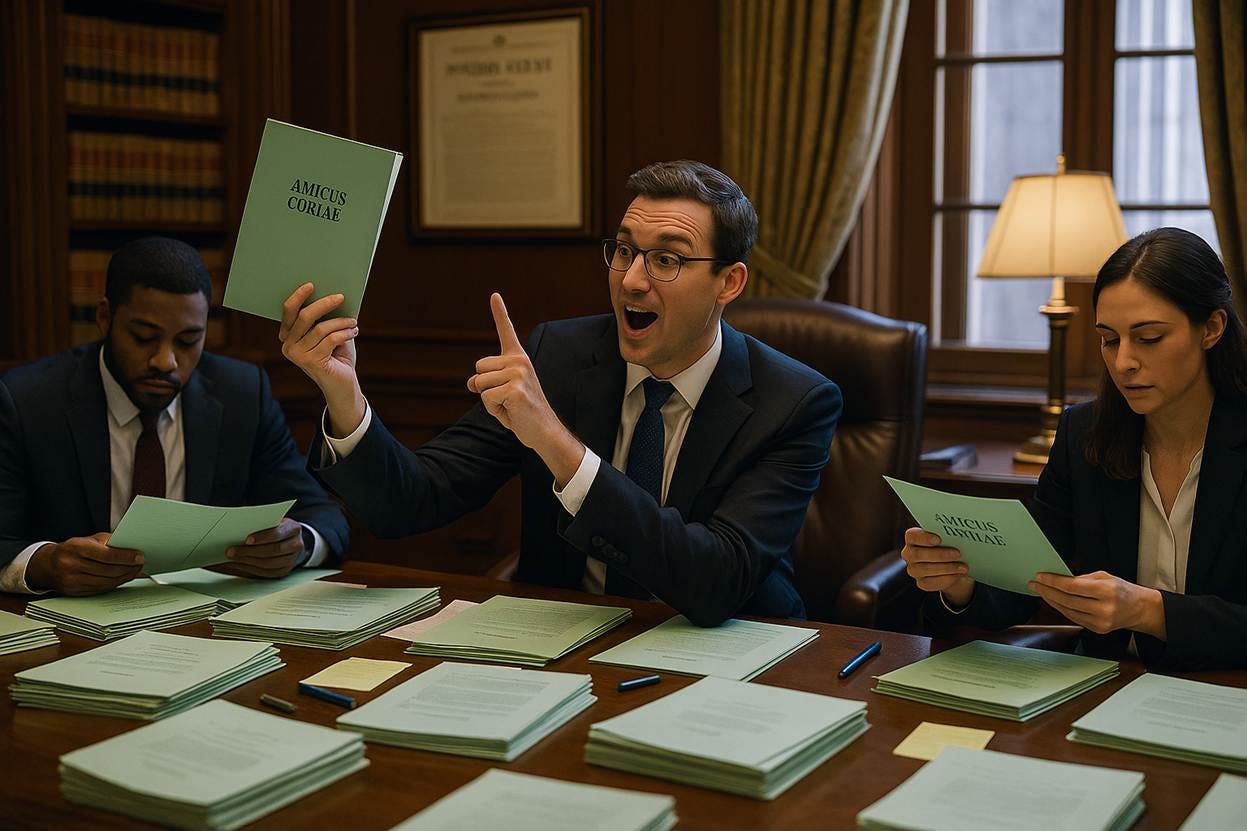When Amicus Briefs Write the Law
A dive into how the Supreme Court adopts language from amicus briefs and just how much text is utilized.
In June 2024, the Supreme Court ruled that cities can enforce anti-camping ordinances without violating the Constitution’s ban on cruel punishment. City of Grants Pass v. Johnson drew 85 amicus (friend-of-the-court) briefs—from governors and police groups, business coalitions and homeless advocates. Each wanted to shape how the Court framed the problem.
Some succeeded. When the majority opinion appeared, whole phrases that originated in those briefs had migrated into the Court’s language, now binding on every lower court in the country.
One filing stood out. The Criminal Law and Punishment Scholars, represented by Gregory Cui of the MacArthur Justice Center, offered a crisp formulation about criminal intent: “Crime, as a compound concept, generally [is] constituted only from concurrence of an evil-meaning mind with an evil-doing hand.”
The Court’s opinion echoed it almost word-for-word: “This view took deep and early root in American soil where, to this day, a crime ordinarily arises only from concurrence of an evil-meaning mind with an evil-doing hand.”
That borrowed phrase now defines the boundary between punishable conduct and protected status—not just in Grants Pass, but in homeless-rights litigation nationwide. The scholars’ brief contributed 279 unique phrases to the opinion—roughly 5.7 percent of that brief’s distinctive language, the highest rate among all 85 amicus filings in the case.
The Question That Matters
Supreme Court watchers count how many briefs get filed and how often the Justices cite them. Those tallies show who showed up and who got mentioned. They don’t reveal whose words became law.
For advocates and policymakers, that’s what matters. When the Court adopts particular phrasing on a contested issue, it sets the vocabulary for a decade of litigation. Lower courts quote those sentences. Regulators rely on those definitions. Legislatures borrow those frames.
This article measures something traditional metrics miss: when distinctive language from an amicus brief reappears, verbatim, in the majority opinion. Not just influence in the abstract—actual phrases, five words at a time, that moved from private advocacy into published doctrine. The analysis reveals which amicus filers see the highest uptake of their distinctive language, how those patterns cluster by case type and advocate, and what the concentration of textual influence tells us about how doctrine gets its vocabulary. The top 15 briefs in terms of overall shared language with their respective opinions are also detailed below.
Building on Prior Work
Empirical study of borrowed language at the Supreme Court began with Pamela Corley’s 2008 examination of parties’ merits briefs, which demonstrated that roughly 10 percent of majority-opinion text overlaps with the parties’ filings. Subsequent work extended that foundation. Corley has additional work with Collins and Hamner focusing specifically on amicus brief overlap.
A 2016 study of “lifted” opinions identified cases where briefs served as templates for entire sections of Court prose, with particular attention to Justice Blackmun’s reliance on Solicitor General briefs. A 2017 analysis of opinion construction across the Roberts Court showed that party briefs are the Court’s most-used linguistic resource, followed by lower-court opinions and then amicus briefs, with use varying by case complexity and salience. A 2017 collaboration introduced plagiarism-detection software as a triage tool for identifying the most distinctive amicus briefs in high-volume cases.
The remaining gap is a transparent, replicable way to show when an amicus’s phrasing becomes the Court’s phrasing—and to measure distinctive contribution after filtering out what parties and other amici already said.
How the Method Works
The approach is straightforward. Every brief and opinion from the past two terms (2023 and 2024) gets broken into overlapping five-word sequences—call them “shingles.” For each amicus brief, this article first subtracts any phrase that already appears in the parties’ filings or in other amicus briefs. What remains is that brief’s unique contribution.
Then I searched the majority opinion for exact matches.
Two measures emerge. The first asks: of a brief’s distinctive language, how much appears in the opinion? The second flips the lens: of the opinion’s novel phrasing—language not borrowed from the parties—how much traces back to amici?
Filings from the petition stage are excluded. Party briefs and other amicus briefs serve as controls. This doesn’t prove causation. Justices may already favor certain turns of phrase. But when distinct wording from a brief appears verbatim in an opinion, the simplest explanation is that the brief supplied language the Court chose to use.
The Briefs That Landed
Across recent Supreme Court terms, five amicus briefs stood out for the sheer volume of their language the Court adopted. Each tells a story about what makes brief-writing effective.



